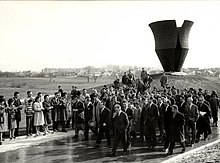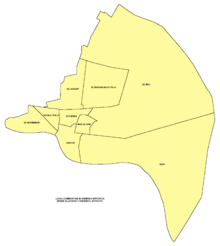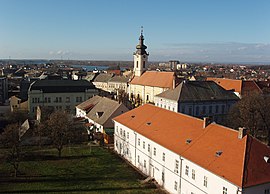|
Sremska Mitrovica
Sremska Mitrovica (Serbian pronunciation: [srêːmskaː mîtroʋitsa]; Serbian Cyrillic: Сремска Митровица, Latin: Sirmium) is a city in Serbia. It is situated on the left bank of the Sava river. As of 2022[update], the city has a total population of 40,144 inhabitants, while its administrative area has a population of 72,580 inhabitants. As Sirmium, it was a capital of the Roman Empire during the Tetrarchy of 4th century CE. Ten Roman emperors were born in or near this city, Emperors Herennius Etruscus (251), Hostilian (251), Decius Traian (249–251), Claudius Gothicus (268–270), Quintillus (270), Aurelian (270–275), Probus (276–282), Maximian (285–310), Constantius II (337–361) and Gratian (367–383). NameThe modern town name is Sremska Mitrovica (Serbian: Сремска Митровица). The Hungarian name was Szávaszentdemeter while in Croatian it is referred to as Srijemska Mitrovica.[3][4] Mitrovica stems from Saint Demetrius or "Sveti Dimitrije" in Serbian. Sremska Mitrovica means Mitrovica of Syrmia with Sremska distinguishing it from Kosovska Mitrovica.[5][6] The name of the city during the reign of the Roman Empire was Sirmium.[7] Beginning in 1180 AD the name changed from "Civitas Sancti Demetrii" to "Dmitrovica", "Mitrovica", and finally to the present form - "Sremska Mitrovica". History
Ancient Sirmium  Sremska Mitrovica is one of the oldest cities in Europe. Archaeologists have found a trace of organized human life dating from 5000 BC onwards. Ionian jewellery dating to 500BC was excavated in the city. When the Romans conquered the city in the 1st century BC, Sirmium already was a settlement with a long tradition. In the 1st century, Sirmium gained a status of a colony of the citizens of Rome, and became a very important military and strategic location in Pannonia province. The war expeditions of Roman emperors Trajan, Marcus Aurelius, and Claudius II, were prepared in Sirmium.[citation needed] In 103, Pannonia was split into two provinces: Pannonia Superior and Pannonia Inferior, and Sirmium became the capital city of the latter. In 296, Diocletian implemented a new territorial division of Pannonia. Instead of previous two provinces, there were four new provinces established in former territory of original Pannonia: Pannonia Prima, Pannonia Valeria, Pannonia Savia and Pannonia Secunda. Capital city of Pannonia Secunda was Sirmium.[citation needed] In 293, with the establishment of tetrarchy, the Roman Empire was split into four parts; Sirmium became one of the four capital cities of the Empire, the other three being Augusta Treverorum, Mediolanum, and Nicomedia (modern Trier, Milan and Izmit). During the tetrarchy, Sirmium was the capital of emperor Galerius. With the establishment of praetorian prefectures in 318, the capital of the prefecture of Illyricum was Sirmium.[citation needed] Beginning in the 4th century, the city was an important Christian centre, and was a seat of the Episcopate of Sirmium. Four Christian councils were held in Sirmium. At the end of the 4th century, Sirmium was brought under the sway of the Goths, and later, was again annexed to the Eastern Roman Empire. In 441, Sirmium was conquered by the Huns, and after this conquest, it remained for more than a century in the hands of various Germanic tribes, such were Eastern Goths and Gepids.[citation needed] For a short time, Sirmium was the center of the Gepide State and the king Cunimund minted golden coins in it. After 567, Sirmium was again incorporated into Eastern Roman Empire. The city was conquered and destroyed by Avars in 582. This event marked the end of the period of late Antiquity in the history of Sirmium.[citation needed] 11 luxurious golden belts of Avar handicraft dating to the 6th century was excavated in the vicinity.[8] After the Avar conquestFor the next two centuries Sirmium was a place of little importance. At the end of the 8th century, Sirmium belonged to the Frankish State. The historical role of Sirmium increased again in the 9th century, when it was part of the Bulgarian Empire. Pope Adrian II gave St Methodius the title of Archbishop of Sirmium. After having adopted Christianity, the Bulgarians restored in Sirmium the Christian Episcopate, having in mind old Christian traditions and the reputation this city had in the ancient world.[citation needed] In the 11th century, Sirmium was a residence of Sermon, a duke of Syrmia, who was a vassal of the Bulgarian Samuil. After 1018, the city was again included into the Byzantine Empire, and since the end of the 11th century, Sirmium was a subject of a dispute between the Byzantine Empire and the Kingdom of Hungary, until 1180 when the Byzantine Empire gave up Sirmium, surrendering it to the Kingdom of Hungary. In the 11th century, a Byzantine province named Theme of Sirmium had its capital in this city.[citation needed] Emperor Basil II (976–1025) created administrative system in which Sirmium was a seat of strategos Serbias.[9] For a while, about 1451, the city was in possession of the Serbian despot Đurađ Branković. In 1521 the city came into Ottoman hands and it remained under the Ottoman rule for almost two centuries. According to Ottoman traveler Evliya Çelebi, Mitrovica had been conquered by the Bosnian sanjak bey Husrev-bey. It was renamed as "Dimitrofça".[citation needed] The name of the mayor of the city was Dimitar and since the middle of the 16th century, the city was mostly populated with Muslims. According to the 1566/69 data, the population of the city was composed of 592 Muslim and 30 Christian houses, while according to the 1572 data, it was composed of 598 Muslim and 18 Christian houses.[citation needed] According to the 1573 data, the city had 17 mosques and no Christian church. During the Ottoman rule, Sremska Mitrovica was the largest settlement in Syrmia, and was the administrative center of the Ottoman Sanjak of Syrmia. It was temporarily occupied by Austrian troops between 1688 and 1690. They finally took it in 1717 and took possession of it after signing Treaty of Passarowitz in 1718.[citation needed] With the establishment of the Habsburg administration in 1718, the Muslim population fled from the city and was replaced with Serbian, Croatian, and German settlers. According to the 1765 data, the population of the city numbered 809 people, of whom 514 were Serbs and 290 Catholics.[citation needed] Sremska Mitrovica was part of the Habsburg Military Frontier (Slavonian Krajina). In 1848–49, it was part of the Serbian Voivodship, a Serb autonomous region within Austrian Empire, but in 1849, it was returned under administration of the Military Frontier. With the abolition of the Slavonian Military Frontier in 1881, Sremska Mitrovica was included into Syrmia County, which was part of the Kingdom of Croatia-Slavonia within Austria-Hungary. According to the 1910 census, the population of the city numbered 12,909 people, of which 8,793 spoke the Serbo-Croatian language (4,878 of those spoke Serbian and 3,915 spoke Croatian) and 2,341 German. The administrative area of the city (which did not included the city itself) had 32,012 inhabitants, of which 28,093 spoke Serbo-Croatian (27,022 of those spoke Serbian and 1,071 spoke Croatian) and 2,324 German.[citation needed] After the First World WarIn 1918, the Austro-Hungarian monarchy collapsed and the Syrmia region first became a part of the newly formed State of Slovenes, Croats and Serbs, and then, on 24 November 1918, the assembly of Syrmia in Ruma decided most of Syrmia (including Mitrovica) would join the Kingdom of Serbia.[citation needed] Subsequently, on 1 December 1918, Kingdom of Serbia united with the Kingdom of Montenegro and the State of Slovenes, Croats and Serbs to form the Kingdom of Serbs, Croats and Slovenes (renamed to Yugoslavia in 1929). Between 1918 and 1922, Sremska Mitrovica was part of the Syrmia County, between 1922 and 1929 part of the Syrmia Oblast, between 1929 and 1931 part of the Drina Banovina, and, between 1931 and 1941, part of the Danube Banovina.[citation needed]  During World War II, the city was occupied by Axis troops and was attached to the Independent State of Croatia. During that time its name was changed to Hrvatska Mitrovica (meaning Croatian Mitrovica). One of the largest Nazi concentration/death camps in the Independent State of Croatia existed in Sremska Mitrovica and as many as 10,000 victims (Serbs, Jews, and antifascists) were killed here.[10][11] The Serbian Jewish population was to be interned in a concentration camp built first in Jarak and then at Zasavica. However, both locations proved to be too flooded for construction. The Germans had to abandon these locations and use Sajmište, which resulted in the destruction of 83% of Serbian Jewry.[citation needed] In the Yugoslav wars in Sremska Mitrovica Prison, some Croatian prisoners of war were kept in this prison. The main prison facility; the largest known in Serbia, was open from November 1991 to August 1992 and was a scene where many prisoners were killed, tortured, abused and raped.[12] Beginning in 1944, the town was part of the Autonomous Province of Vojvodina within the new Socialist Yugoslavia and, from 1945, within the Socialist Republic of Serbia. From 1992 to 2003 it was part of the Federal Republic of Yugoslavia, which was then transformed into the state union of Serbia and Montenegro. Since the 2006 independence of Montenegro, Sremska Mitrovica is part of an independent Serbia.[citation needed] Inhabited places  The city of Sremska Mitrovica includes the town of Mačvanska Mitrovica, and several villages. Villages on the northern bank of the river Sava, in the region of Syrmia: Villages on the southern bank of the river Sava, in the region of Mačva: Demographics
According to the 2011 census results, the city administrative area has a population of 79,940 inhabitants.    Ethnic groupsMost of the settlements in the city have an ethnic Serb majority. Stara Bingula is an ethnically mixed settlement with a relative Serbian majority. The main concentration of ethnic minorities is in the urban area of the city.[citation needed] The ethnic composition of the city:
ReligionIn 2002, the population of city of Sremska Mitrovica included 76,290 Orthodox Christians, 3,935 Roman Catholics, 252 Protestants and 106 Muslims. Orthodox Christians in Sremska Mitrovica are belonging to the Eparchy of Syrmia of the Serbian Orthodox Church. Catholics belong to the Diocese of Syrmia, which has its seat in Sremska Mitrovica.[citation needed] ClimateSremska Mitrovica has a humid subtropical climate bordering very closely on a humid continental climate (Köppen climate classification: Dfb) as well as an oceanic climate (Köppen climate classification: Cfb).
Economy The following table gives a preview of total number of registered people employed in legal entities per their core activity (as of 2018):[17]
Sport
Notable residentsRoman emperors Ten Roman emperors were born in the city and its environs:
The last emperor of the united Roman Empire, Theodosius I (378–95), became emperor in Sirmium. The usurpers Ingenuus and Regalianus also declared themselves emperors in this city (in 260) and many other Roman emperors spent some time in Sirmium including Marcus Aurelius who might have written parts of his famous work Meditations in the city.[citation needed] Classical antiquity
Middle agesModern period
International relationsTwin towns – sister citiesSremska Mitrovica is twinned with: See also
References
External linksWikivoyage has a travel guide for Sremska Mitrovica. Wikimedia Commons has media related to Sremska Mitrovica. |
||||||||||||||||||||||||||||||||||||||||||||||||||||||||||||||||||||||||||||||||||||||||||||||||||||||||||||||||||||||||||||||||||||||||||||||||||||||||||||||||||||||||||||||||||||||||||||||||||||||||||||||||||||||||||||||||||||||||||||||||||||||||||||||||||||||||||||||||||||||||||||||||||||||||||||||||||||||||||||||||||||||||||||||||||||||||||||||||||||||||||












